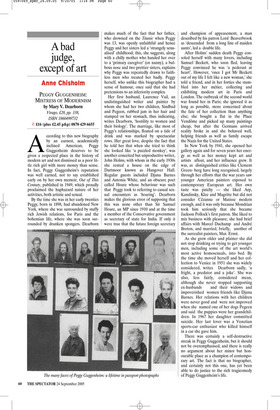A bad judge, except of art
Anne Chisholm
PEGGY GUGGENHEIM: MISTRESS OF MODERNISM by Mary V. Dearborn Virago, £20, pp. 338, ISBN 1860499732 ✆ £16 (plus £2.45 p&p) 0870 429 6655 According to this new biography by an earnest, academically inclined American, Peggy Guggenheim deserves to be given a respected place in the history of modern art and not dismissed as a poor little rich girl with more money than sense. In fact, Peggy Guggenheim’s reputation was well earned, not to say established early on by her own memoir, Out of This Century, published in 1949, which proudly proclaimed the haphazard nature of her activities, both artistic and sexual.
By the time she was in her early twenties Peggy, born in 1898, had abandoned New York, where she was surrounded by stuffy rich Jewish relations, for Paris and the bohemian life, where she was soon surrounded by drunken spongers. Dearborn makes much of the fact that her father, who drowned on the Titanic when Peggy was 13, was openly unfaithful and hence Peggy and her sisters led a ‘strangely sexualised’ childhood; this, she suggests, along with a chilly mother who handed her over to a ‘primary caregiver’ (or nanny), a bulbous nose and two prettier sisters, explains why Peggy was repeatedly drawn to faithless men who treated her badly. Peggy herself, who unlike this biographer had a sense of humour, once said that she had pretensions to an inferiority complex.
Her first husband, Laurence Vail, an undistinguished writer and painter by whom she had her two children, Sindbad and Pegeen, rubbed jam in her hair and stamped on her stomach, thus indicating, writes Dearborn, ‘hostility to women and their biology’. The marriage, like most of Peggy’s relationships, floated on a tide of drink and was marked by spectacular rows. Her great love, despite the fact that he told her that when she tried to think she looked like ‘a puzzled monkey’, was another conceited but unproductive writer, John Holms, with whom in the early 1930s she rented a house on the edge of Dartmoor known as Hangover Hall. Regular guests included Djuna Barnes and Antonia White, and an obscure poet called Hoare whose behaviour was such that Peggy took to referring to casual sexual encounters as ‘hoaring’. Dearborn makes the glorious error of supposing that this was none other than Sir Samuel Hoare, an MP since 1910 and at the time a member of the Conservative government as secretary of state for India. If only it were true that the future foreign secretary and champion of appeasement, a man described by his patron Lord Beaverbrook as ‘descended from a long line of maiden aunts’, led a double life.
After Holms’ sudden death Peggy consoled herself with many lovers, including Samuel Beckett, who soon fled, leaving Peggy convinced he was ‘a pederast at heart’. However, ‘once I got Mr Beckett out of my life I felt like a new woman,’ she told a friend, and in her forties she stumbled into her métier, collecting and exhibiting modern art in Paris and London. The outbreak of the second world war found her in Paris; she ignored it as long as possible, more concerned about the fate of her collection than anything else; she bought a flat in the Place Vendôme and picked up many paintings cheap, but after the Germans arrived reality broke in and she behaved well, helping friends as well as family escape the Nazis for the United States.
In New York by 1941, she opened her gallery again and for seven years her energy as well as her money kept art and artists afloat, and her influence grew. It was, as distinguished critics like Clement Greenberg have long recognised, largely through her efforts that the war years saw younger American painters exposed to contemporary European art. Her own taste was patchy — she liked Arp, Kandinsky, Klee and Magritte but did not consider Cézanne or Matisse modern enough, and it was only because Mondrian took him seriously that she became Jackson Pollock’s first patron. She liked to mix business with pleasure; she had brief affairs with Marcel Duchamp and André Breton, and married, briefly, another of the surrealist painters, Max Ernst.
As she grew older and plainer she did not stop drinking or trying to get younger men, including some of the art world’s most active homosexuals, into bed. By the time she moved herself and her collection to Venice in 1951 she was widely considered, writes Dearborn sadly, ‘a fright, a predator and a joke’. She was also, less fairly, considered mean, although she never stopped supporting ex-husbands and their widows and impoverished women friends like Djuna Barnes. Her relations with her children were never good and were not improved when she named one of her dogs Pegeen and said the puppies were her grandchildren. In 1967 her daughter committed suicide. Her last lover was a Venetian sports-car enthusiast who killed himself in a car she gave him.
There was certainly a self-destructive streak in Peggy Guggenheim, but it should not be overemphasised, and there is really no argument about her minor but honourable place as a champion of contemporary art. The fact is that no biographer, and certainly not this one, has yet been able to do justice to the rich tragicomedy of Peggy Guggenheim’s life.
































































 Previous page
Previous page